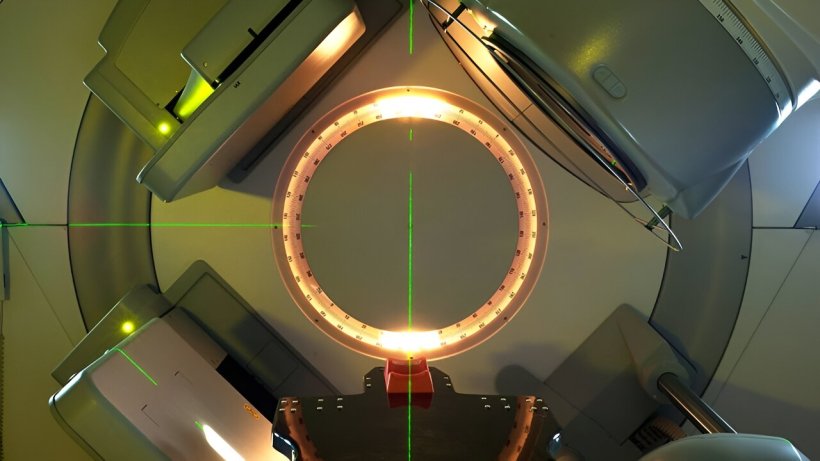
Image credit: Jan Chlebik/the ICR
News • Encouraging results of DARS trial
A ‘new gold standard’ for head and neck cancer radiotherapy
Phase III trial results on a precision radiotherapy technique support a ‘new gold standard’ for treating head and neck cancer patients.
The research suggests the new approach can reduce the risk of swallowing problems after radiotherapy, without impacting the success of treatment. The Dysphagia-Aspiration Related Structures (DARS) trial, which was sponsored by The Royal Marsden and coordinated by the Clinical Trials and Statistics Unit at The Institute of Cancer Research, London, with funding from Cancer Research UK, compared dysphagia-optimised intensity modulated radiotherapy (DO-IMRT) with standard IMRT.
Final results from the trial were published in The Lancet Oncology.
Oncologists and physicists spend some additional time designing the treatment based on the size and position of the tumour. A computer will then plan the dose and route[...]. These tweaks to the treatment can significantly improve quality of life
Chris Nutting
DO-IMRT optimises IMRT to reduce the risk of swallowing difficulties, known as dysphagia. This common side effect of radiotherapy for head and neck cancer can, in some cases, leave patients needing a permanent feeding tube. DO-IMRT lowers the risk of dysphagia by reducing radiation to the pharyngeal muscles, which support swallowing. The DARS study included 112 newly diagnosed participants with oropharyngeal and hypopharyngeal cancers (tumours of the throat) from centres across the UK and Ireland. Half received standard IMRT and half received DO-IMRT for six weeks.
The trial revealed that:
- After two years, patients treated with DO-IMRT were more likely to report better swallowing function than those treated with IMRT.
- After a year, around three fifths (62%) of DO-IMRT patients reported high normalcy of diet - meaning they were still able to eat at least some foods that require chewing – and over 8 in 10 (85%) said they felt comfortable eating in public, compared with just under 45% and 75% of those treated with standard IMRT respectively.
- After just over three years of follow up, there was no evidence of a difference in survival rates between the two approaches.
Study lead Professor Chris Nutting, Consultant Clinical Oncologist at The Royal Marsden NHS Foundation Trust and Professor of Radiation Oncology at The Institute of Cancer Research, London, said: “The final results from this study support a new gold standard for treating head and neck cancer patients with radiotherapy. We have demonstrated that this targeted form of radiotherapy can spare the swallowing muscles of patients without impacting the success of their treatment. This approach involves oncologists and physicists spending some additional time designing the treatment based on the size and position of the tumour. A computer will then plan the dose and route which turns the radiation into lots of smaller, more precise beams that help to protect the throat where possible. As these tweaks to the treatment can significantly improve quality of life, we hope more centres will implement this practice.”
We’re delighted our trial has shown it is possible to tailor how we deliver cutting-edge radiotherapy to minimise damage to key muscles and structures involved in swallowing
Emma Hall
Professor Justin Roe, Consultant Speech and Language Therapist and Joint Head of the Department of Speech, Voice and Swallowing at The Royal Marsden NHS Foundation Trust, said: “The vast majority of patients I support have had a head and neck cancer diagnosis and many unfortunately experience swallowing problems during and following treatment, which often includes radiotherapy. I regularly see people who no longer enjoy food and drink, or feel too embarrassed to consume them around others, which can lead to depression and isolation. Dysphagia can also cause other serious medical problems such as malnutrition, dehydration and, in some cases, respiratory complications. It has been a privilege to support this study and I hope to see many more patients benefit from this tailored form of radiotherapy in the future.”
Professor Emma Hall, Co-Director of the Clinical Trials and Statistics Unit at The Institute of Cancer Research, London, which coordinated the trial, said: “Maintaining the ability to eat and drink normally following treatment for head and neck cancer is incredibly important for patients' wellbeing. We’re delighted our trial has shown it is possible to tailor how we deliver cutting-edge radiotherapy to minimise damage to key muscles and structures involved in swallowing, and help more people continue to enjoy eating and drinking following therapy. This is just one example of how advanced radiotherapy techniques like Do-IMRT can help more patients live well, with fewer side effects, after receiving cancer treatment.”
Martin Ledwick, Cancer Research UK’s head nurse, said: "Behind the results of each clinical trial, there are real people who deserve the best possible quality of life. It’s important the interventions not only work, but can be kinder so they are still able to enjoy life’s pleasures. It’s difficult for many of us to imagine not being able to swallow properly, but this can be the reality for head and neck cancer patients post-treatment. These promising results could make life after treatment brighter for head and neck cancer patients, and we look forward to seeing this kinder form of radiotherapy make its way to the clinic.”
Source: The Institute of Cancer Research
27.11.2023











